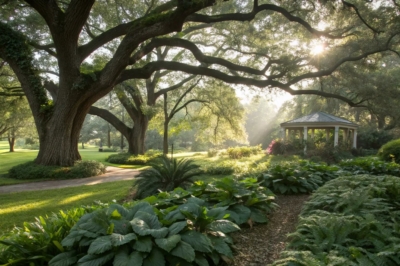1. Embrace the Charm of Hostas
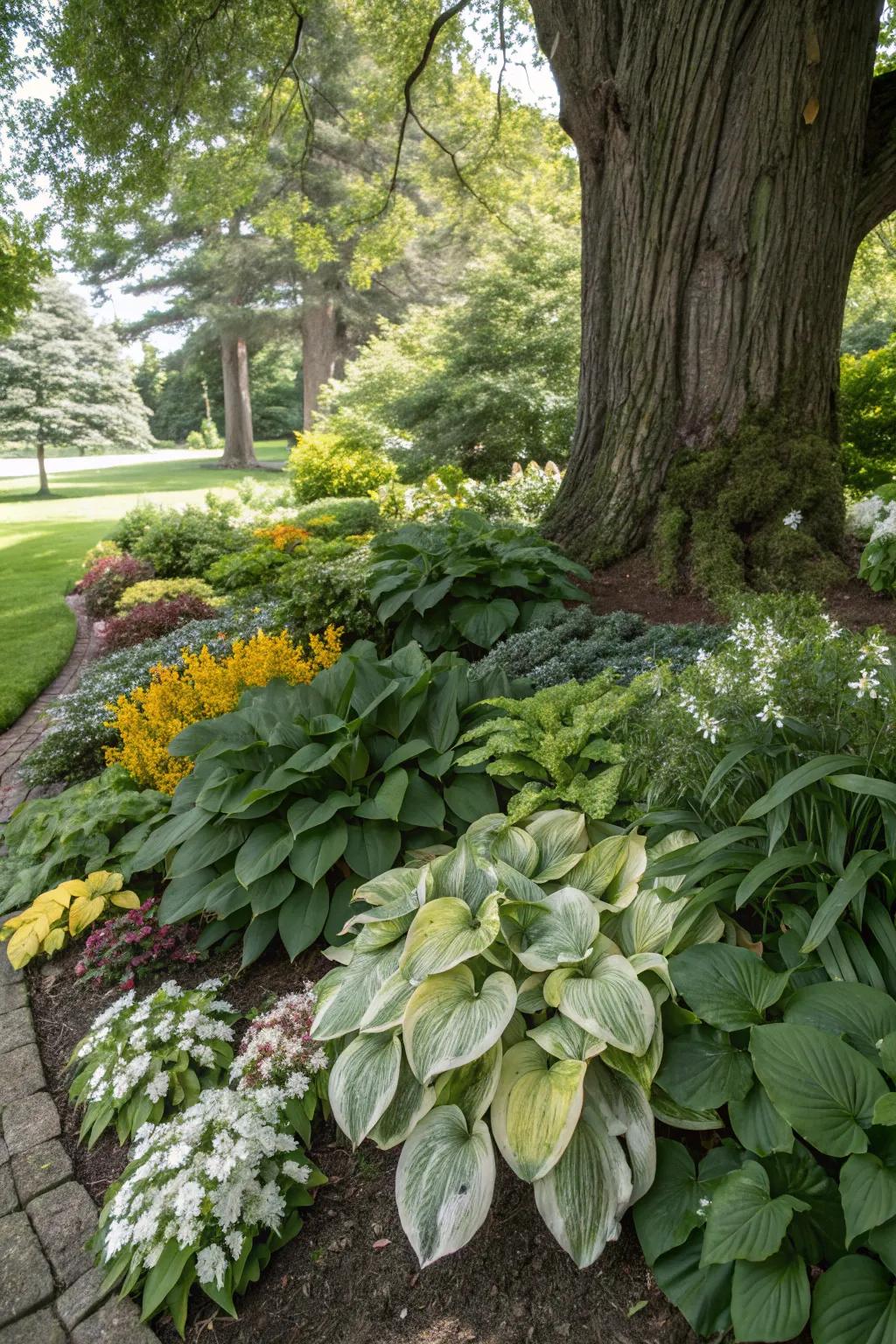
Hostas are my go-to for adding lushness under trees, thanks to their diverse leaf shapes and colors. They’re easy to care for and bring a touch of elegance to any shaded spot.
Useful items to consider:
- Hosta Plant Collection: Add elegance beneath trees with a lush collection of diverse hostas. Perfect for shaded spots.
- Shaded Garden Soil Mix: Ensure your hostas thrive with nutrient-rich soil specifically for shaded garden areas.
- Garden Border Edging: Define your hosta garden with durable, decorative edging for a polished, tidy look.
2. Go Natural with Ground Covers
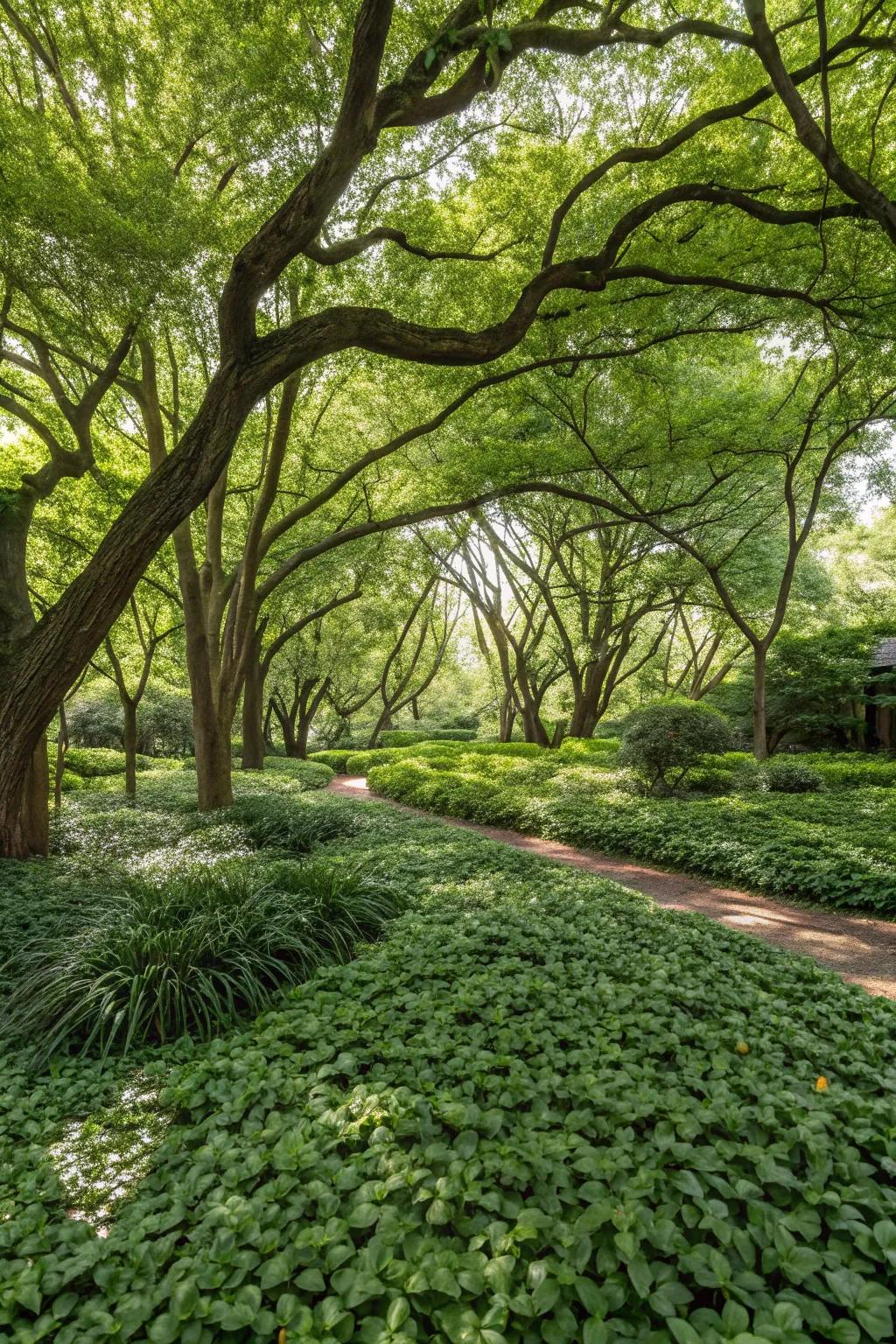
Ground covers like ajuga quickly fill in gaps and provide a dense, weed-resistant mat. They’re my secret weapon for seamless, low-maintenance beauty.
A few choices to try:
- Ajuga Ground Cover Seeds: Plant ajuga seeds to create a lush, weed-resistant ground cover under trees effortlessly.
- Shade Cloth for Trees: Use shade cloth to protect delicate plants beneath trees while promoting healthy growth.
- Garden Soil for Shade Plants: Enhance growth with soil specially formulated for shade-loving plants under trees.
3. Create Depth with Ferns
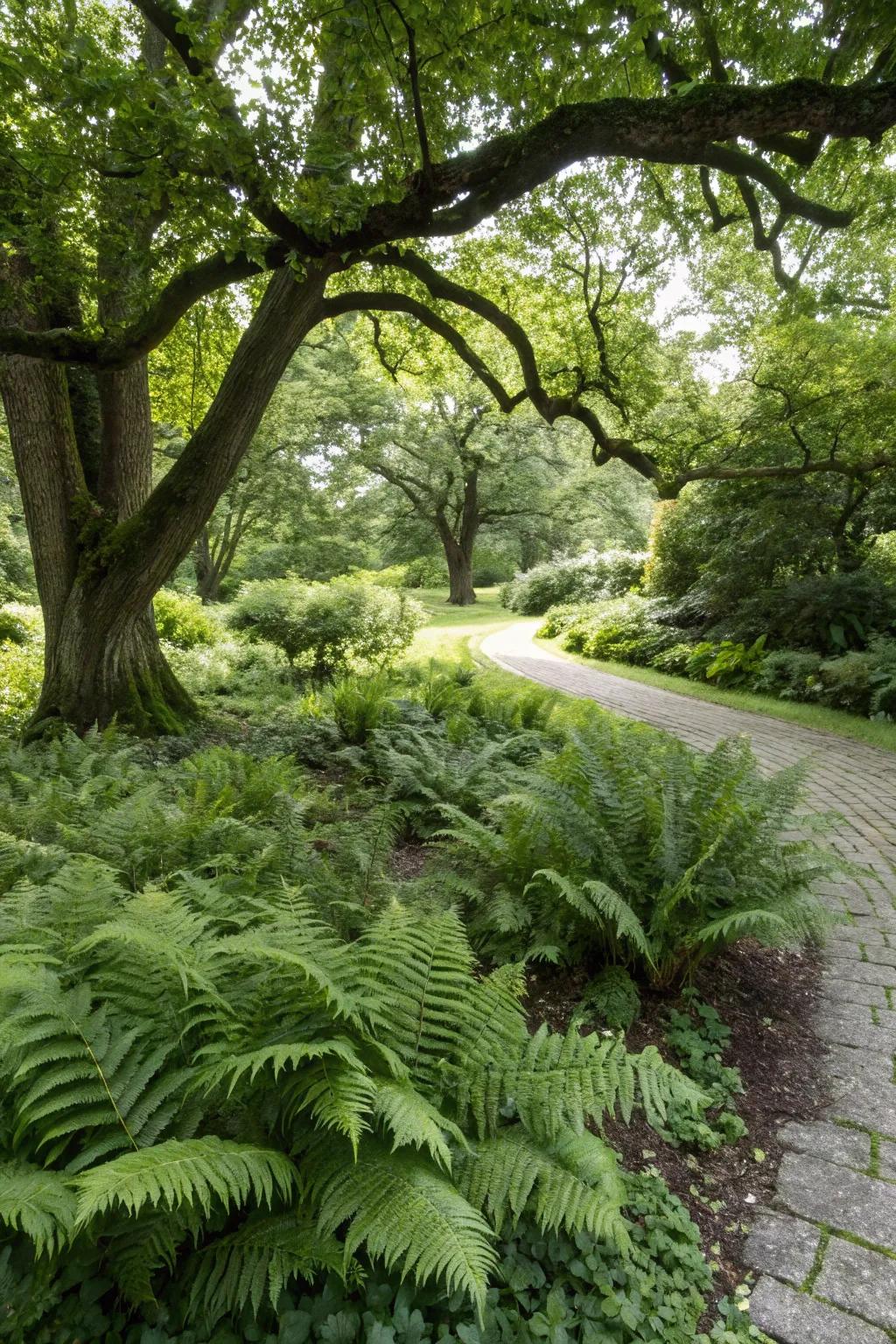
Ferns are perfect for adding a soft, feathery texture under trees. I love how they mimic the natural woodland feel while being easy to maintain.
Give these a look:
- Shade-Tolerant Fern Collection: Add lush greenery under trees with this easy-to-maintain fern collection, perfect for shaded areas.
- Fern Organic Fertilizer: Enhance fern growth naturally with this organic fertilizer, promoting healthier and vibrant foliage.
- Decorative Garden Edging: Define fern beds beautifully with garden edging, creating a tidy and elegant woodland look.
4. Add Edibles for a Surprise
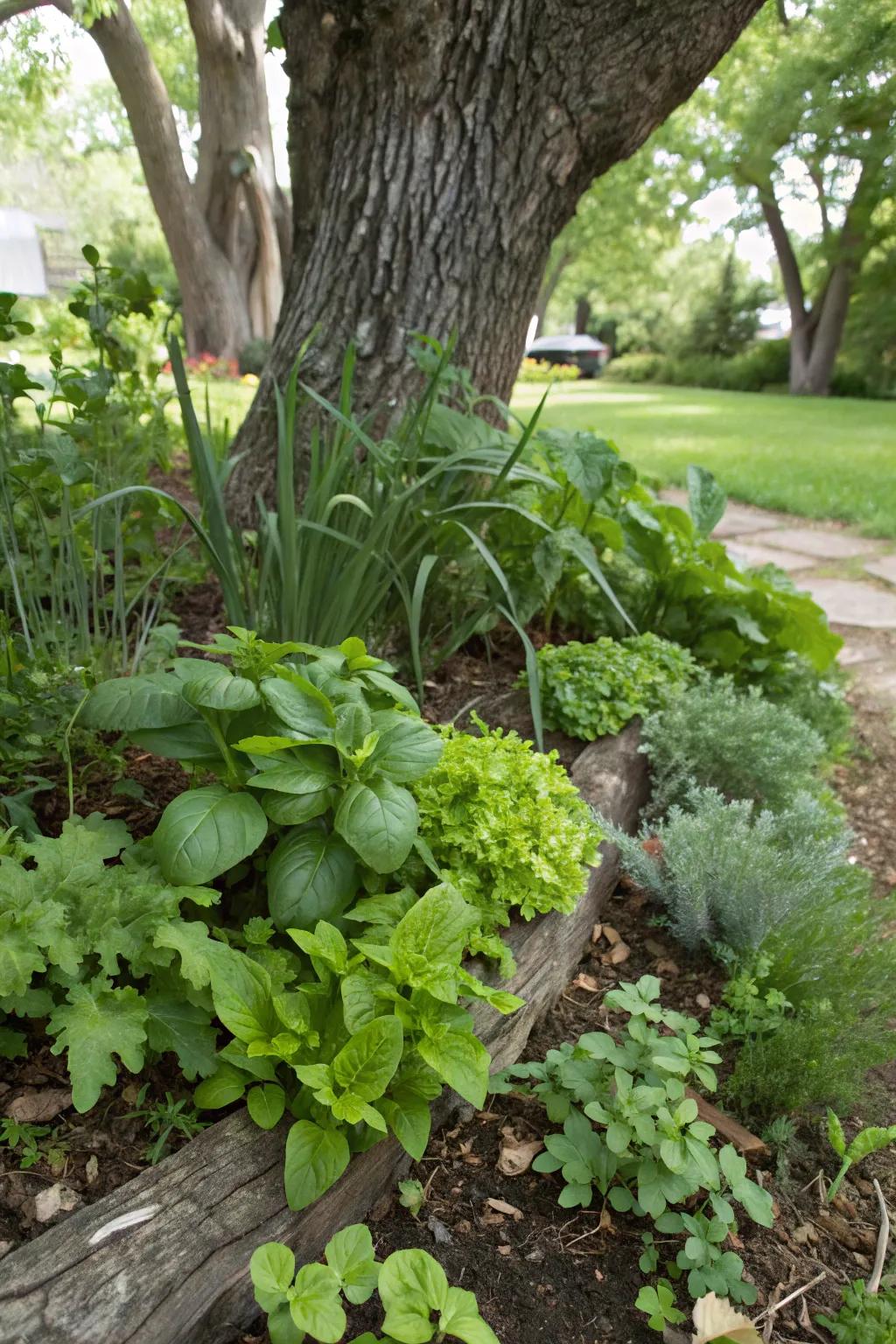
Incorporate edible plants like herbs that thrive in shade. It’s a functional and delightful twist I’ve enjoyed experimenting with.
Might be a good match:
- Shade-Tolerant Herb Seed Kit: Transform your shady garden with this herb seed kit, perfect for culinary enthusiasts.
- Garden Soil for Herbs: Nurture your herbs with this nutrient-rich garden soil, designed for optimal growth under trees.
- Compact Garden Tool Set: Equip yourself with this compact tool set for easy planting and maintenance in tight spaces.
5. Utilize Mulch for Moisture and Style
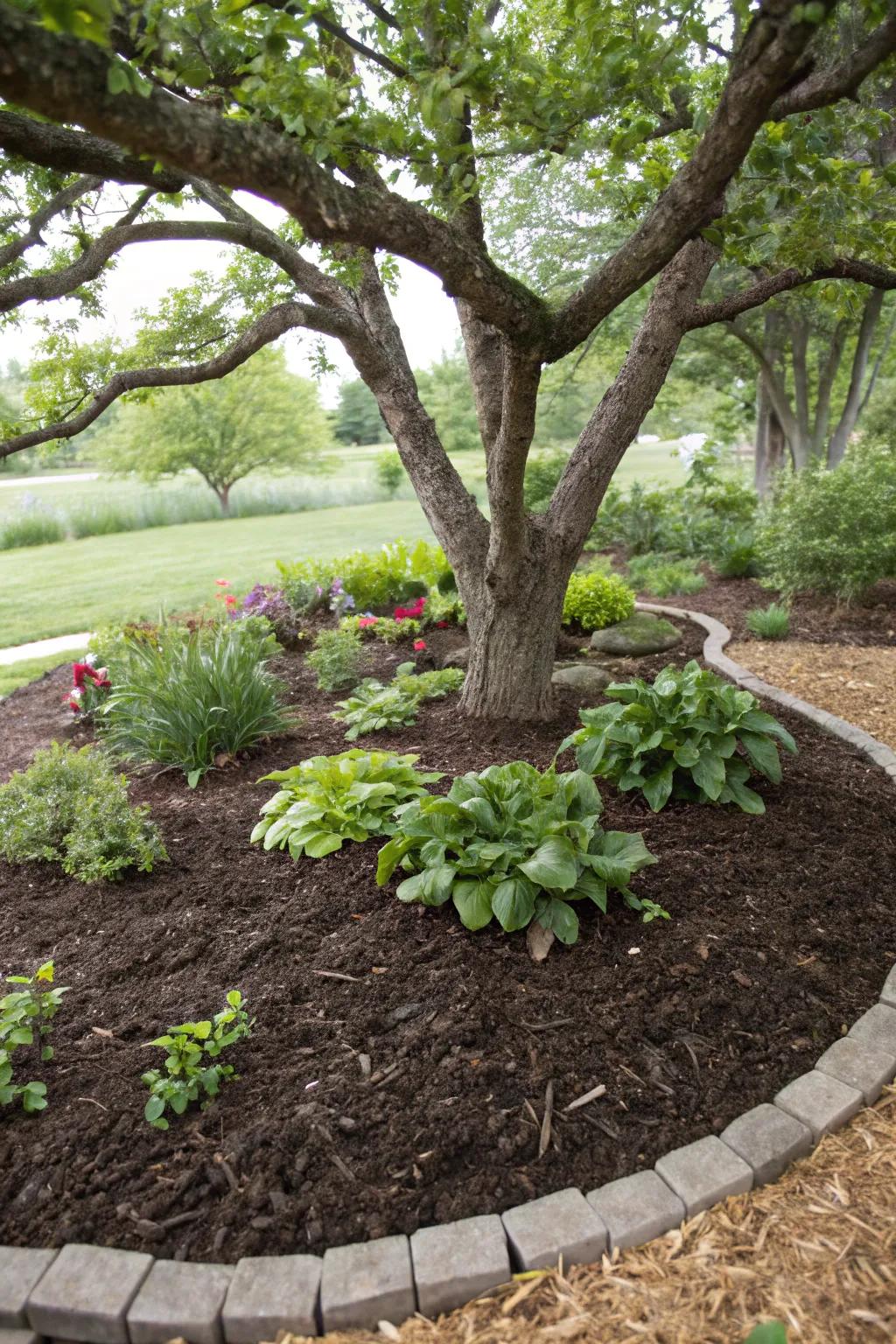
Mulching not only helps retain soil moisture but also adds a neat, finished look to your under-tree garden. It’s my go-to trick for keeping the garden healthy and chic.
Consider these options:
- Organic Bark Mulch: Enhance your garden’s moisture retention and aesthetics with this organic bark mulch.
- Garden Edging Stones: Add a stylish border to your under-tree garden with durable garden edging stones.
- Moisture Retention Garden Fabric: Protect and maintain soil moisture efficiently with this garden fabric beneath your mulch.
6. Add a Splash of Color with Heucheras
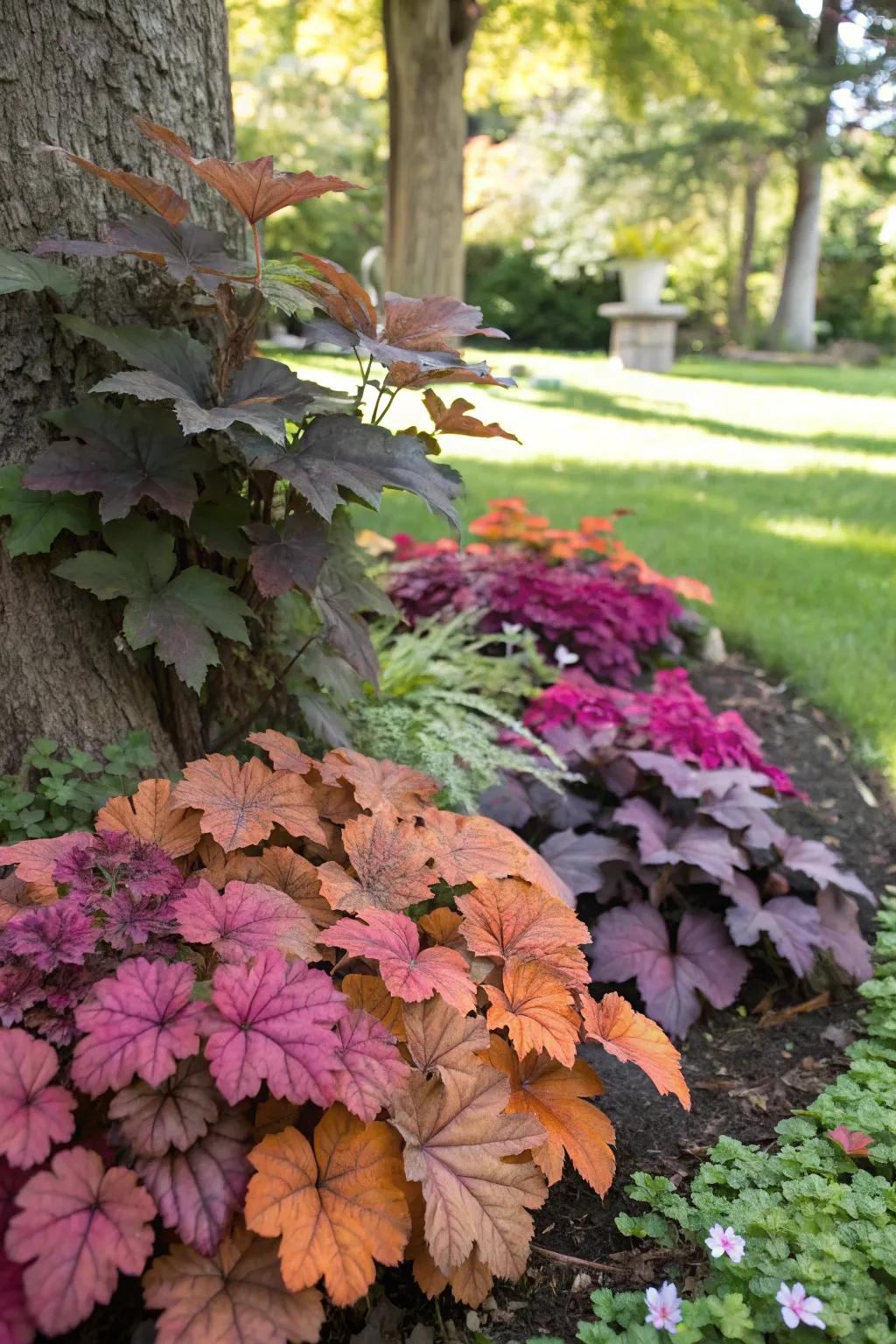
Heucheras offer stunning foliage colors from deep reds to vibrant greens, perfect for adding a pop of color under trees. They’re a favorite in my garden for their year-round appeal.
A few suggestions:
- Heuchera Plant Collection: Transform your garden with vibrant Heucheras, offering a burst of color under your trees.
- Shade-Loving Fertilizer: Boost your Heucheras’ growth with this top-rated shade-loving plant fertilizer and see amazing results.
- Garden Mulch for Perennials: Maintain moisture and enhance your Heucheras’ display with quality mulch, ideal for leafy perennials.
7. Incorporate Seasonal Interest
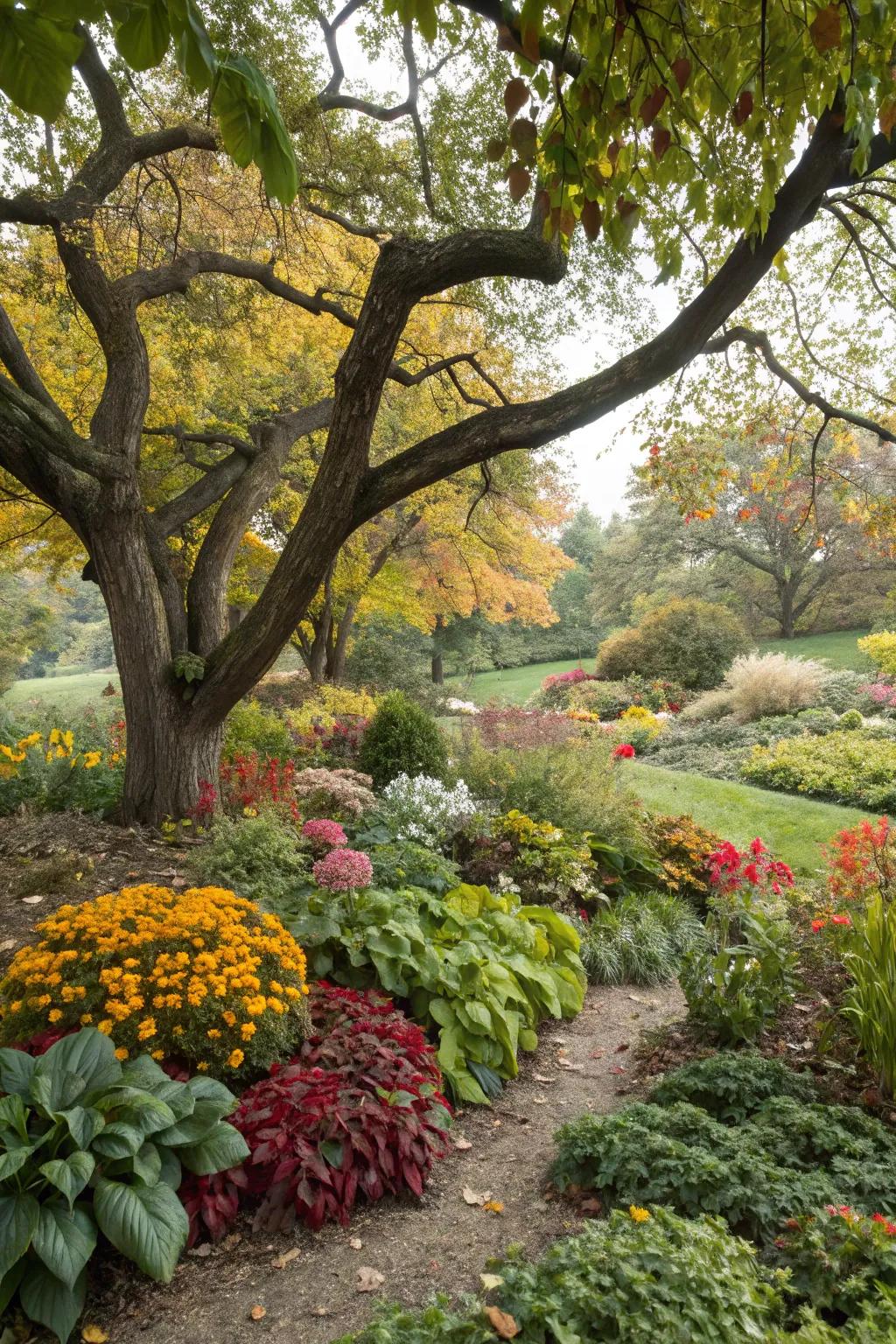
Choose plants that offer something interesting in every season. It’s a trick I use to ensure there’s always something captivating happening under the tree.
A few helpful options:
- Perennial Flower Seed Mix: Brighten your garden year-round with diverse perennials offering seasonal color and texture changes.
- Garden Mulch for Seasonal Change: Enhance soil health and visual appeal with mulch, complementing seasonal plant transformations.
- Decorative Garden Borders: Define your garden with attractive borders, keeping seasonal plants contained and flourishing.
8. Add a Relaxation Nook
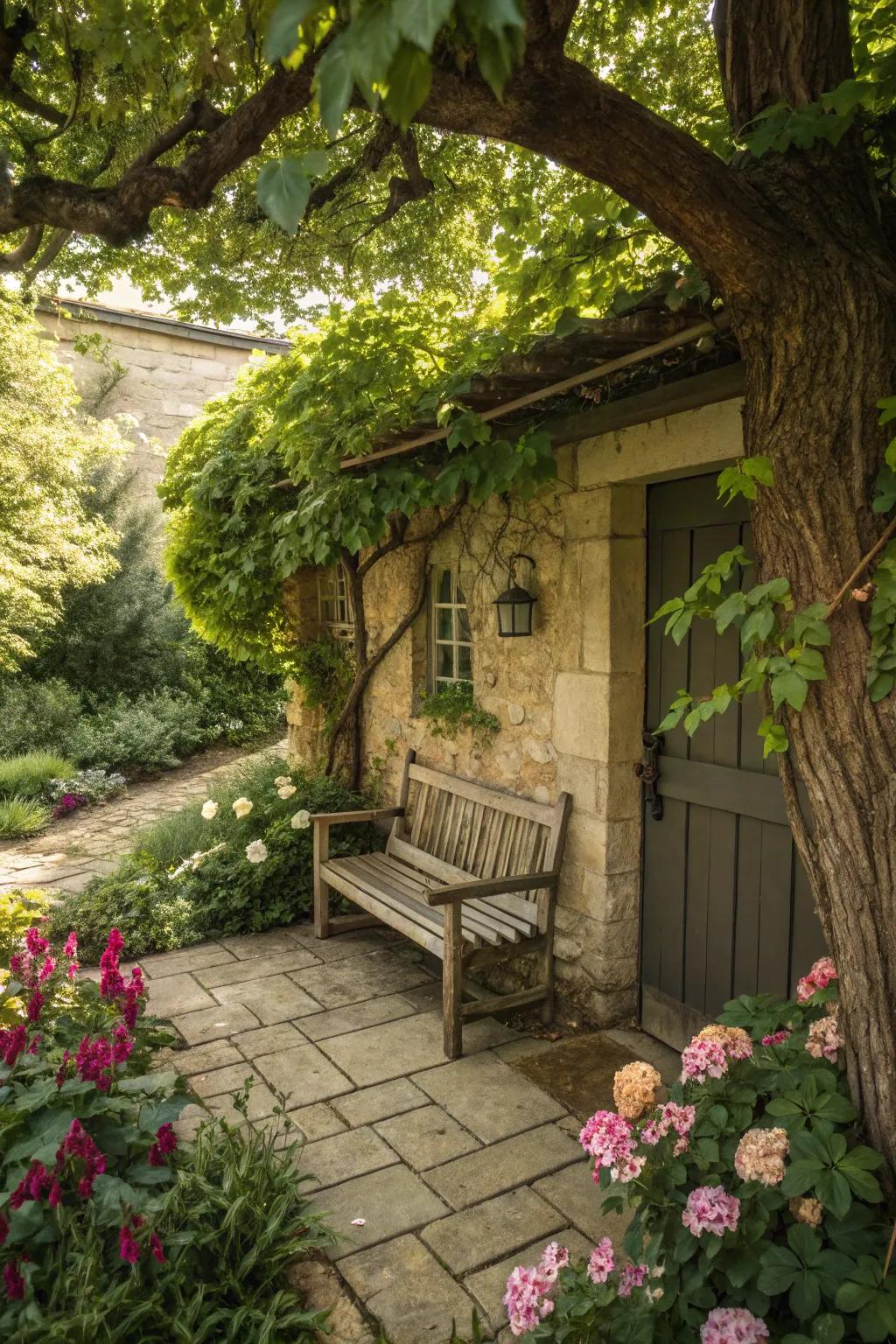
Consider placing a small bench or chair under the tree for a cozy relaxation spot. It’s a place where I often unwind with a good book.
A few relevant products:
- Wooden Garden Bench: Enhance your garden space with a durable wooden bench for ultimate relaxation under the tree.
- Outdoor Throw Pillows: Add comfort and style to your bench with colorful, weather-resistant outdoor throw pillows.
- Solar Garden Lanterns: Illuminate your nook with decorative solar lanterns for a cozy, ambient evening atmosphere.
9. Create a Fairy Garden
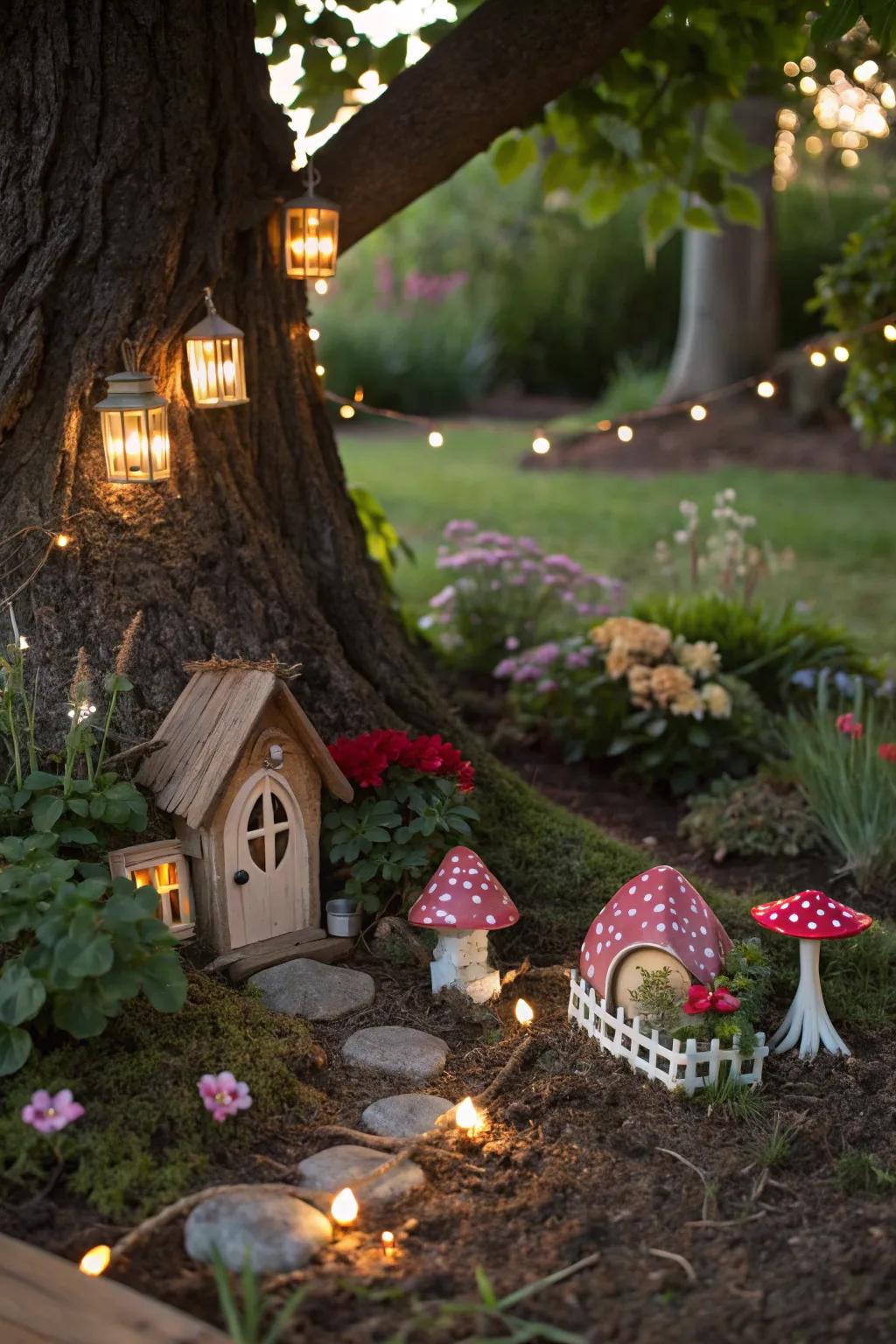
Transform a part of your garden into a miniature fairy world. It’s a whimsical project that adds magic and delight, especially for the young at heart.
Possibly helpful picks:
- Miniature Fairy Garden Accessories Kit: Add charm and enchantment with tiny houses and figures for your fairy garden setup.
- Solar-Powered LED Fairy Lights: Illuminate your fairy garden with eco-friendly, twinkling lights that last through the night.
- Miniature Pathway Stones: Create whimsical pathways that guide fairies through your magical garden retreat.
10. Brighten with Colorful Foliage
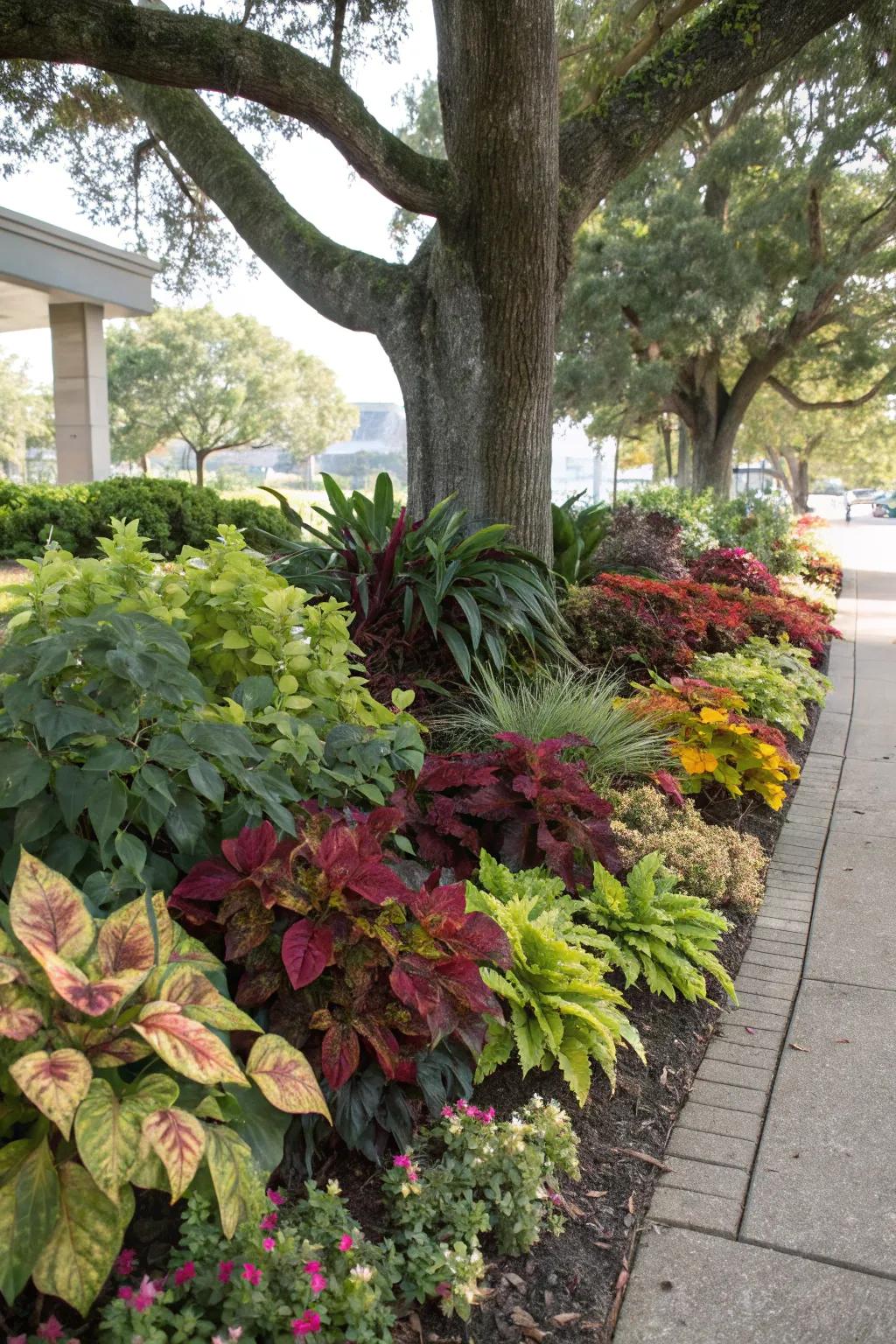
Choose plants with varied foliage colors to brighten shady spots. In my experience, the right foliage can transform a dark area into a vibrant retreat.
Try these:
- Colorful Shade-Loving Plant Mix: Enhance your garden’s appeal with a vibrant mix of shade-tolerant, colorful foliage plants.
- Colorful Ground Cover Plants for Shade: Transform shaded areas with easy-to-maintain ground covers that thrive in limited sunlight.
- Vibrant Foliage Fertilizer for Shade Plants: Boost the color and health of your shaded foliage with this specially formulated fertilizer.
11. Cultivate Naturalistic Designs
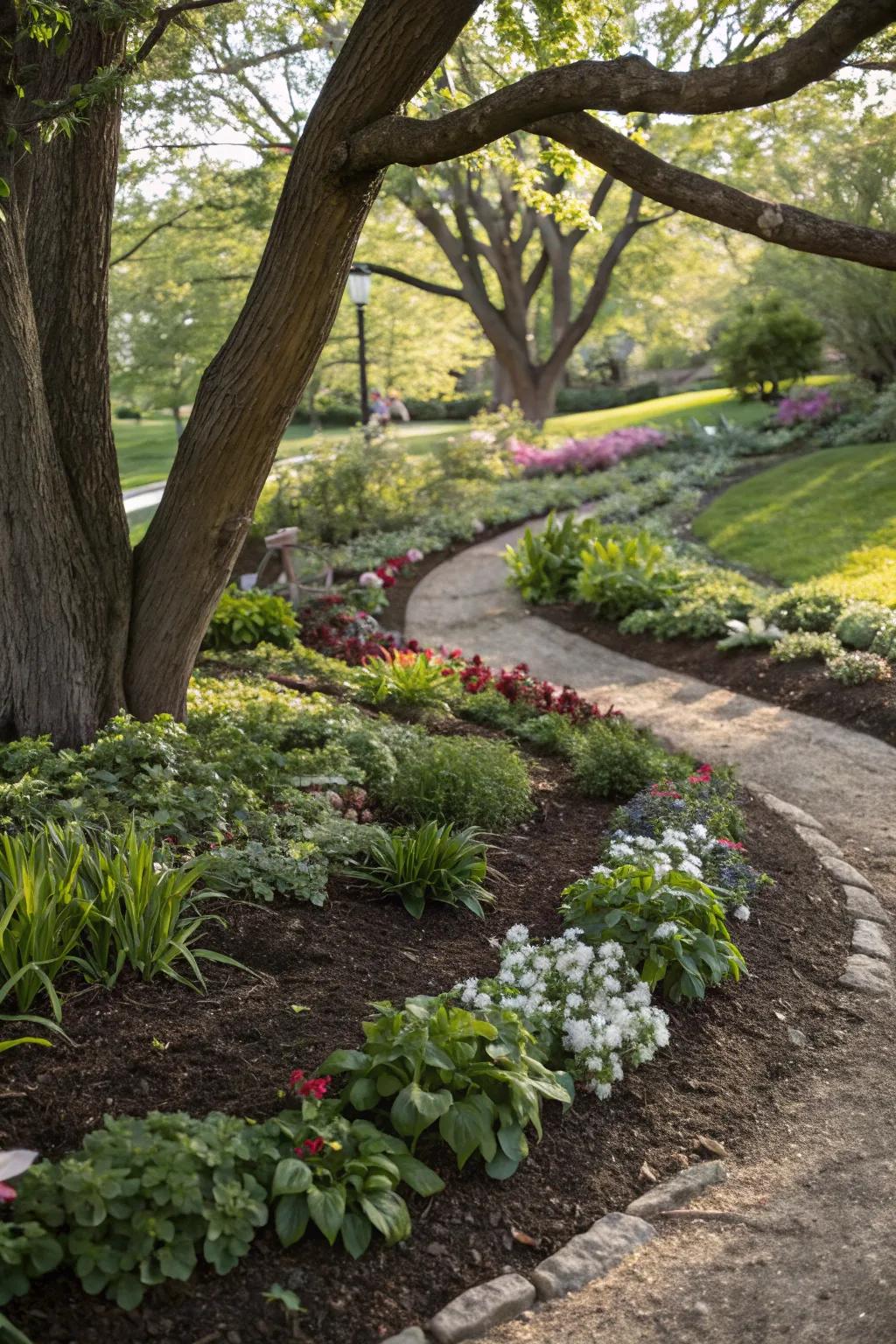
Create flowing garden beds that blend seamlessly with nature. This approach is my favorite for a harmonious and relaxing garden feel.
These products might help:
- Shade-loving Perennial Plants: Enhance your garden’s harmony with shade-loving perennials for naturally lush and vibrant growth.
- Natural Stone Edging: Define garden beds with natural stone edging and blend pathways seamlessly into the landscape.
- Organic Mulch: Use organic mulch to retain moisture and enrich soil for healthier under-tree plantings.
12. Create a Miniature Forest
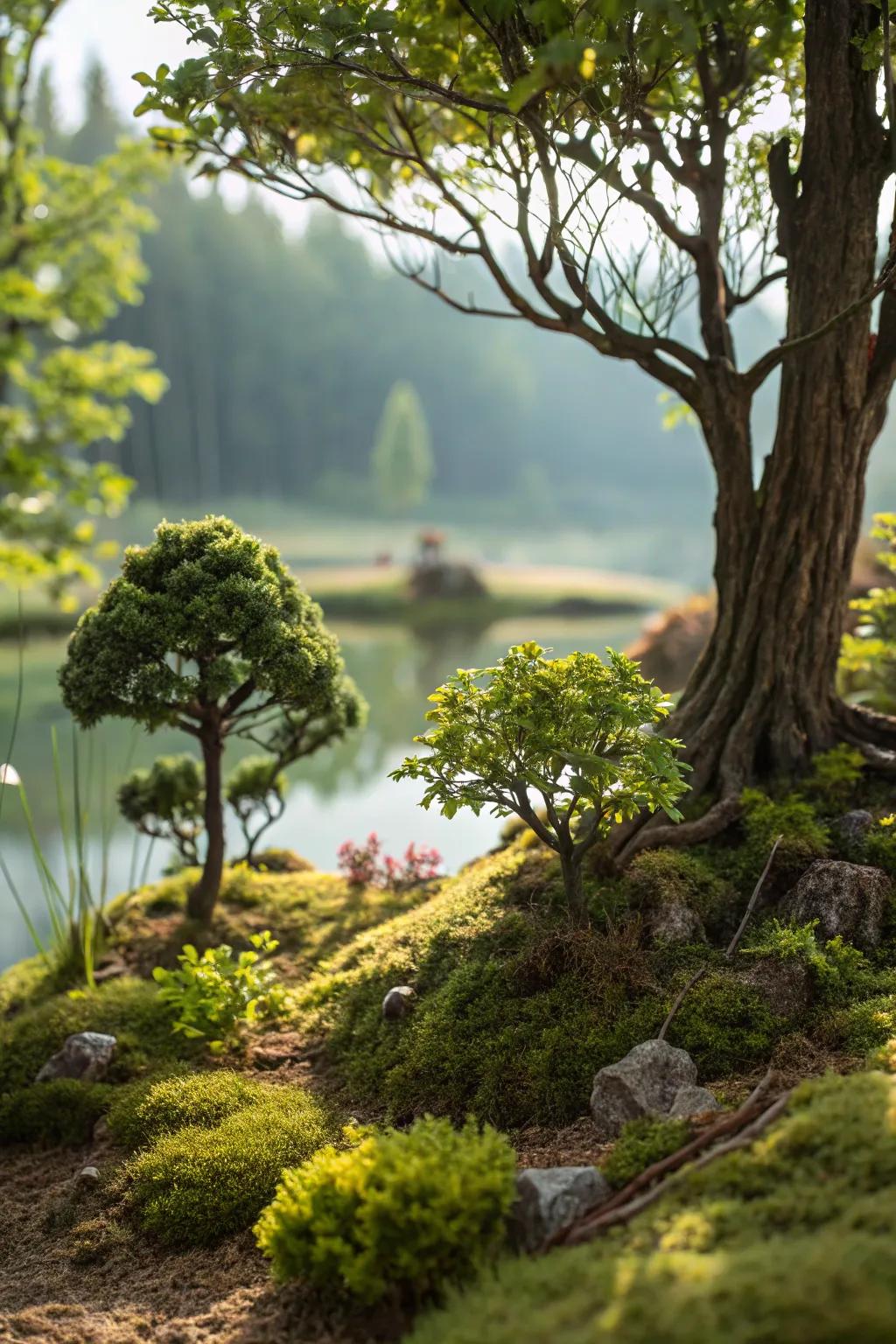
Use a mix of small trees and shrubs to mimic a mini forest under larger trees. It’s a whimsical idea that adds depth and intrigue to your garden.
Explore these options:
- Miniature Bonsai Tree Kit: Cultivate your own tiny forest with a bonsai tree kit, perfect for shaded areas.
- Garden Moss Carpet: Add lush green texture with moss carpets, ideal for a forest floor look.
- Dwarf Shrub Assortment: Enhance your garden with dwarf shrubs, creating depth and visual interest.
13. Plant Spring Bulbs for a Surprise
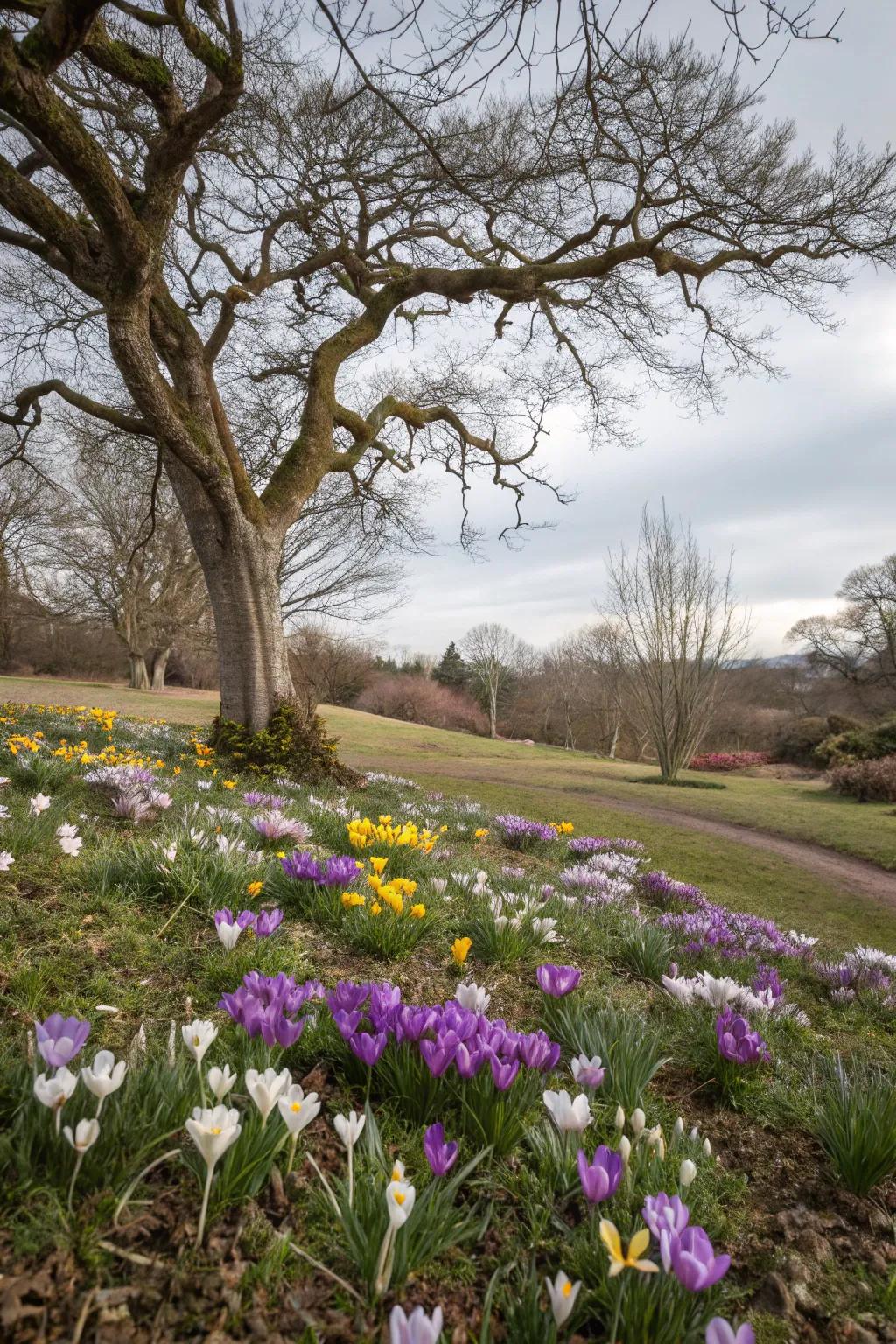
Under deciduous trees, spring bulbs can shine before the leaves fully emerge. This is like a secret surprise I love to reveal each spring.
Check if these fit your needs:
- Mixed Spring Flower Bulb Collection: Transform your garden with a vibrant display of spring bulbs in varied colors and shapes.
- Bulb Planter Tool: Effortlessly plant bulbs with this easy-to-use tool, ensuring perfect depth every time.
- Organic Bulb Fertilizer: Boost bulb growth with organic fertilizer, ensuring lush blooms and healthy plants.
14. Use Rocks for a Natural Look
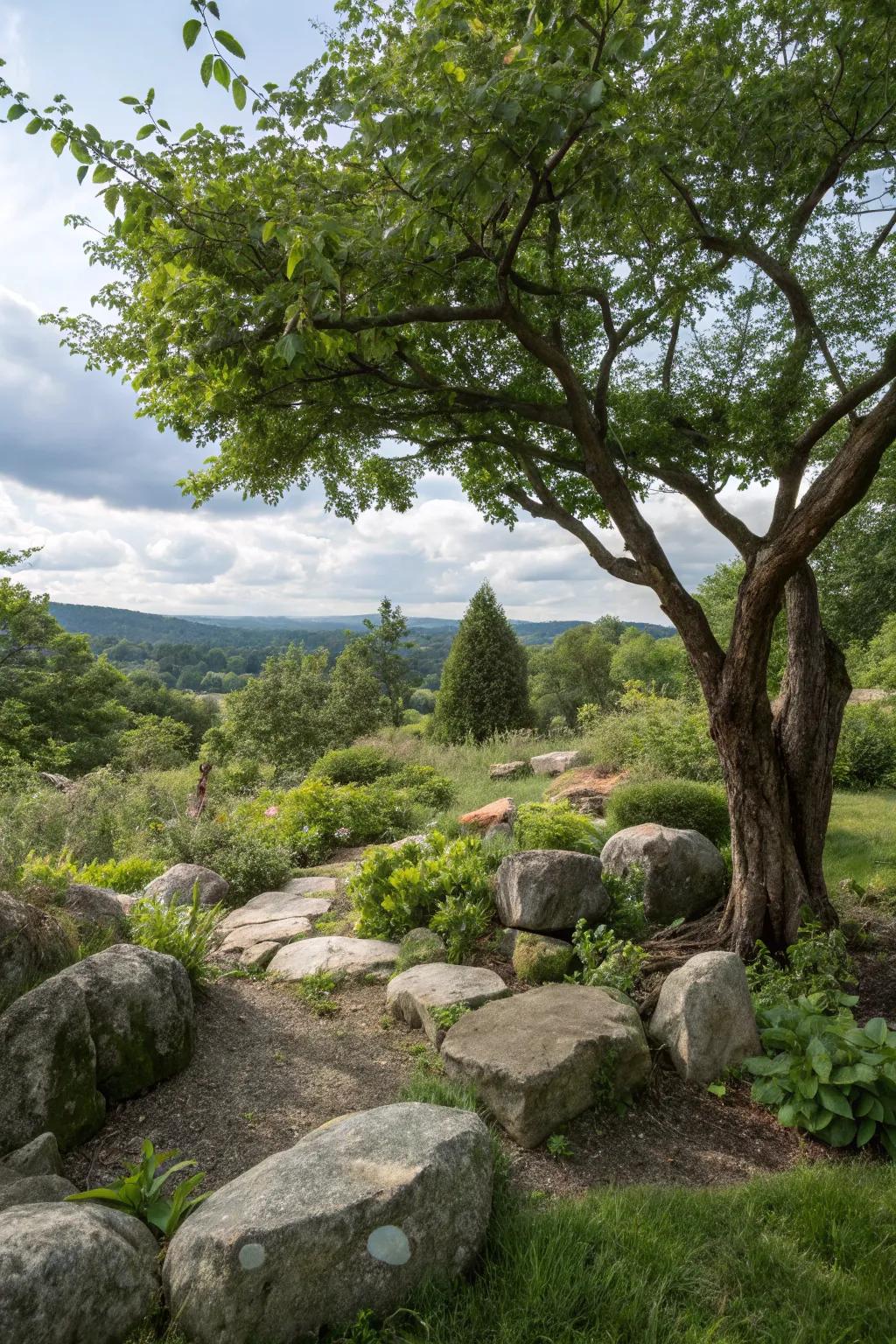
Strategically placed rocks can enhance the natural appeal of your under-tree garden. I find they add a rustic charm that’s hard to beat.
Check these products out:
- Decorative Garden Stones: Enhance your garden’s rustic charm with decorative stones that blend seamlessly with nature.
- Rock Border Edging Kit: Create natural-looking borders around your under-tree garden with an easy-to-use rock edging kit.
- Natural Stone Pathway Pavers: Lay a charming, rustic path with natural stone pavers that integrate beautifully with greenery.
15. Introduce Creeping Vines
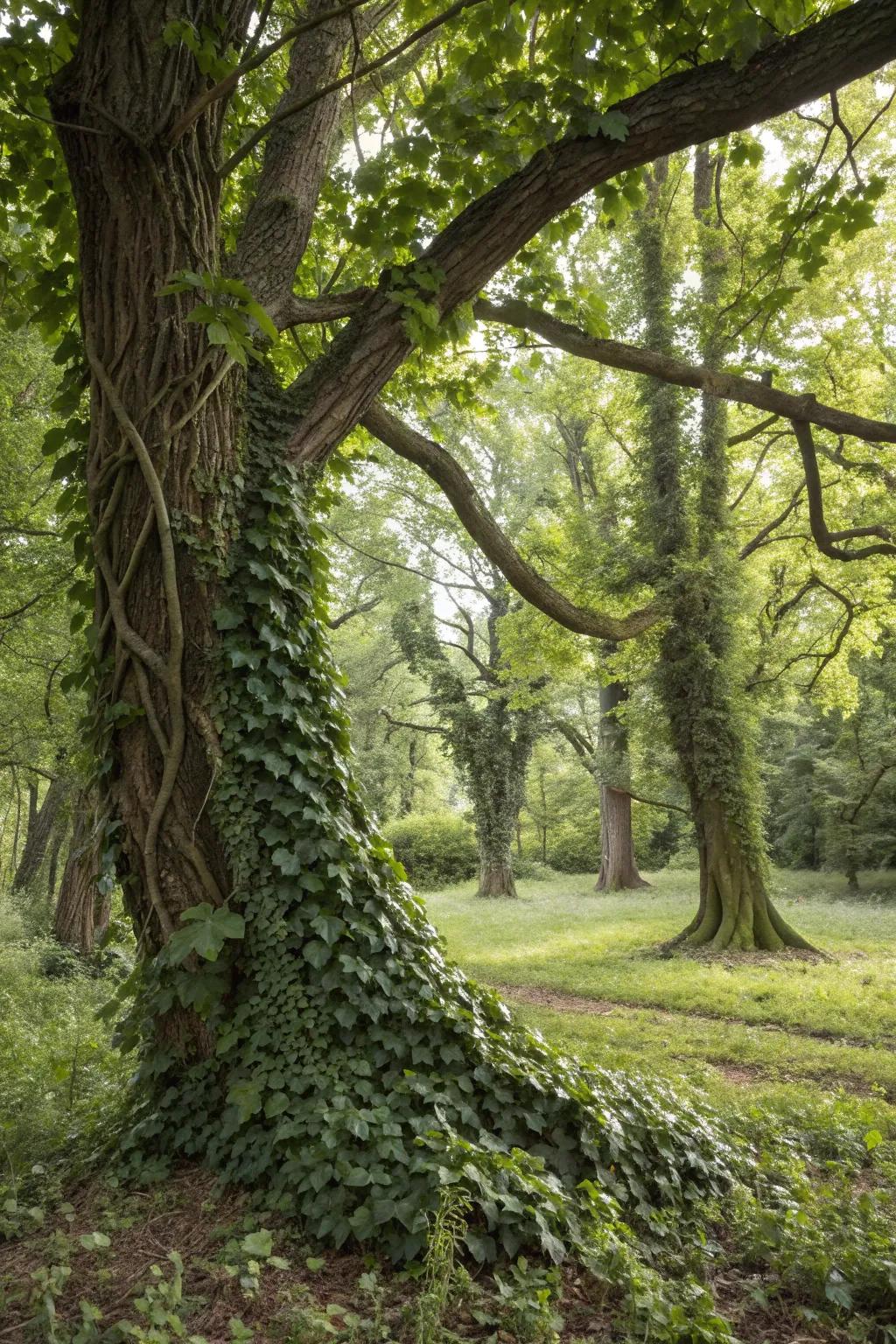
Let vines creep along the ground or climb the tree for added vertical interest. It’s a creative way to use every inch of space in your garden.
May just do the trick:
- Climbing Plant Support Trellis: Enhance your garden with this trellis; let vines add stunning vertical interest effortlessly.
- Outdoor Garden Vine Seeds: Plant these vine seeds and watch them transform your garden with lush greenery under trees.
- Eco-Friendly Garden Twine: Secure your vines smoothly with durable, eco-friendly twine for a neat, vertical garden look.
16. Incorporate Decorative Stones
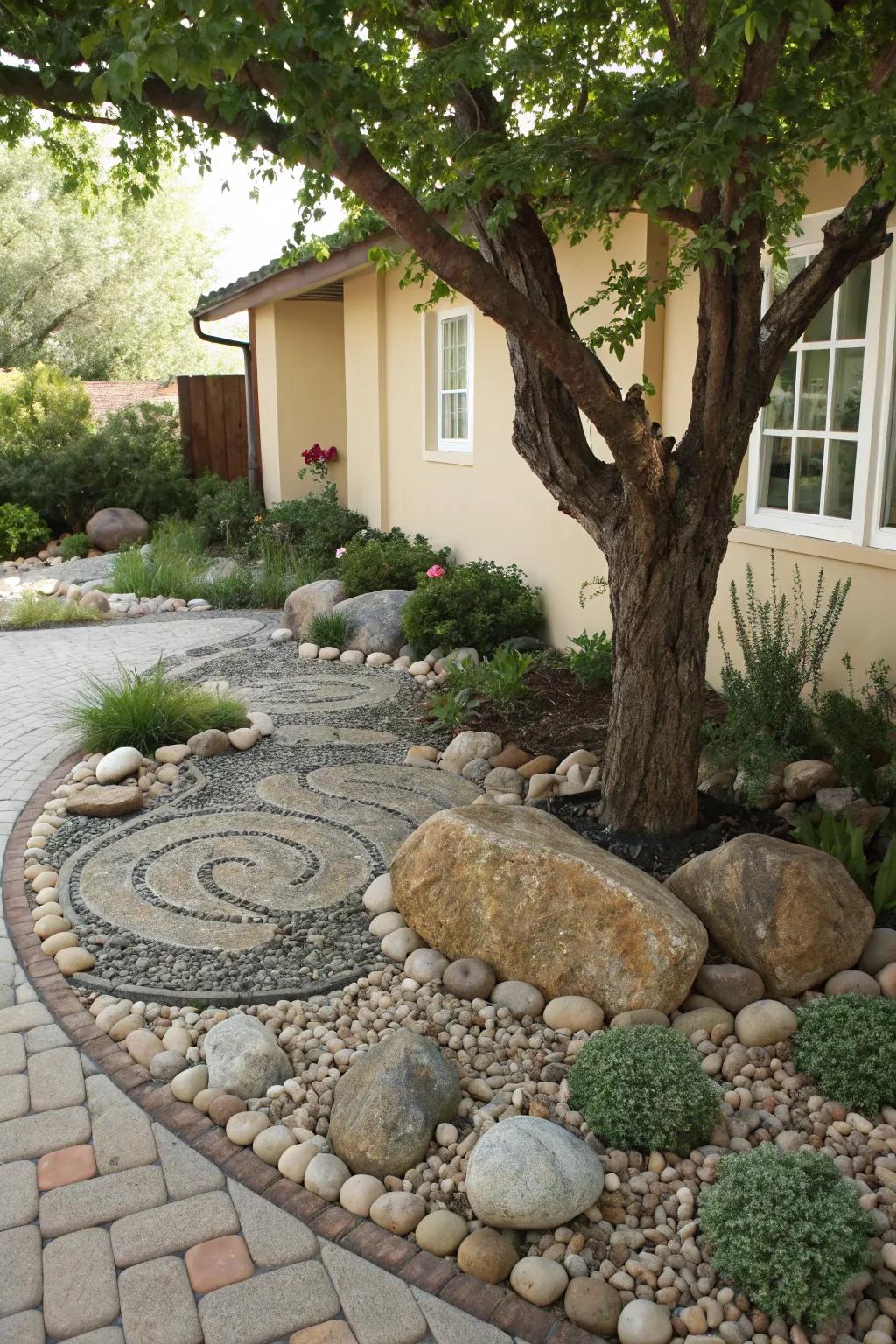
Using decorative stones or pebbles can add texture and visual interest under trees. I love how they provide a clean look and help with drainage.
A few things you might like:
- Natural River Pebbles: Enhance your garden’s aesthetic with smooth, natural pebbles for a stylish and clean look.
- Decorative Garden Stones: Add texture and elegance under your trees with these decorative garden stones.
- Polished Gravel Landscape Rocks: Improve drainage and style with polished gravel rocks suitable for any garden setting.
17. Opt for Drought-Tolerant Selections
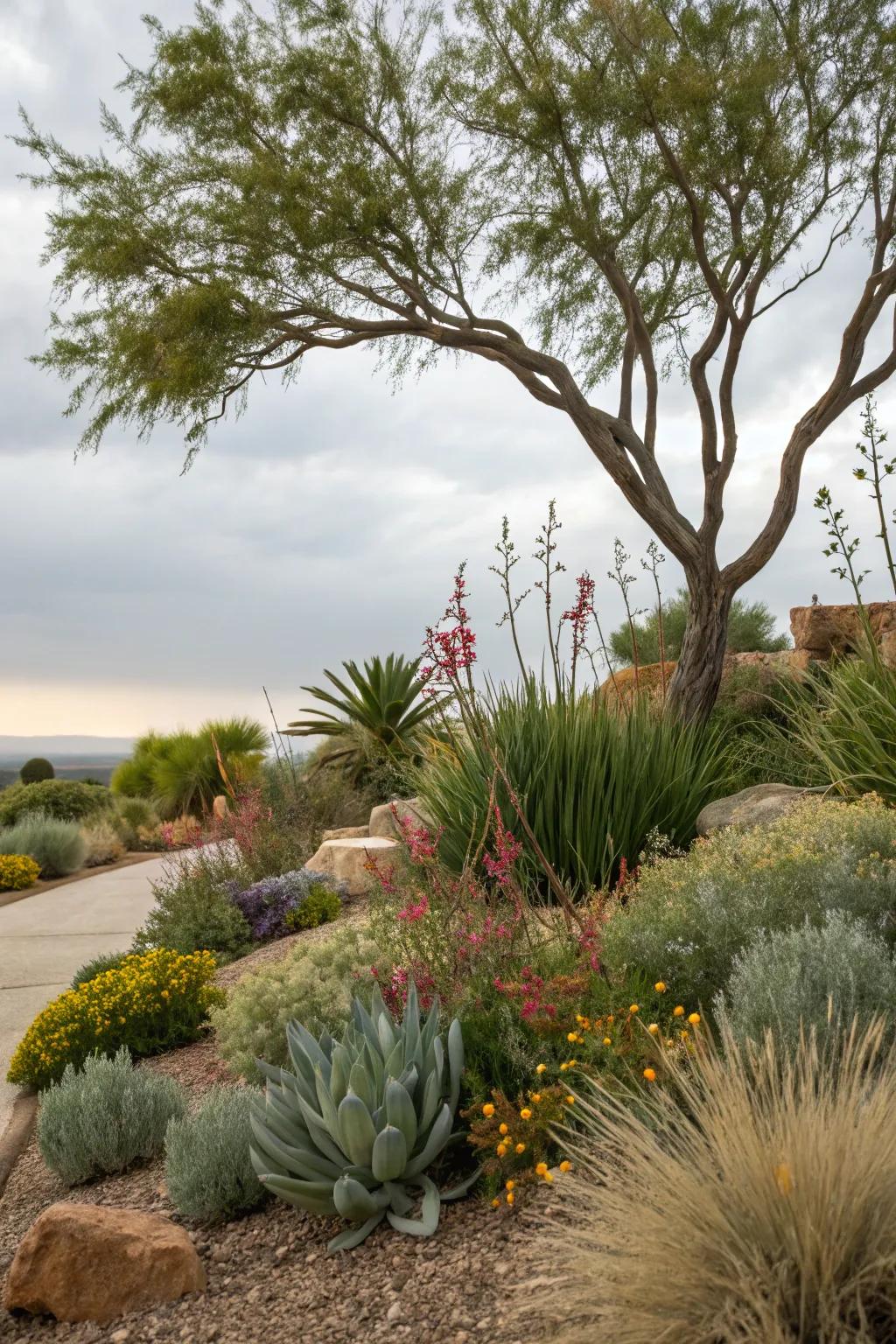
Select drought-tolerant plants that thrive with minimal water. It’s a savvy choice for conserving resources while maintaining a lush garden.
Some handy options:
- Drought-Tolerant Succulent Mix: Enhance your garden with a diverse mix of succulents that thrive in dry conditions.
- Water-Saving Drip Irrigation Kit: Install a drip irrigation system to efficiently water your drought-tolerant plants and conserve resources.
- Mulching Material for Moisture Retention: Apply mulch around your plants to retain soil moisture and reduce watering needs significantly.
18. Try Container Gardening
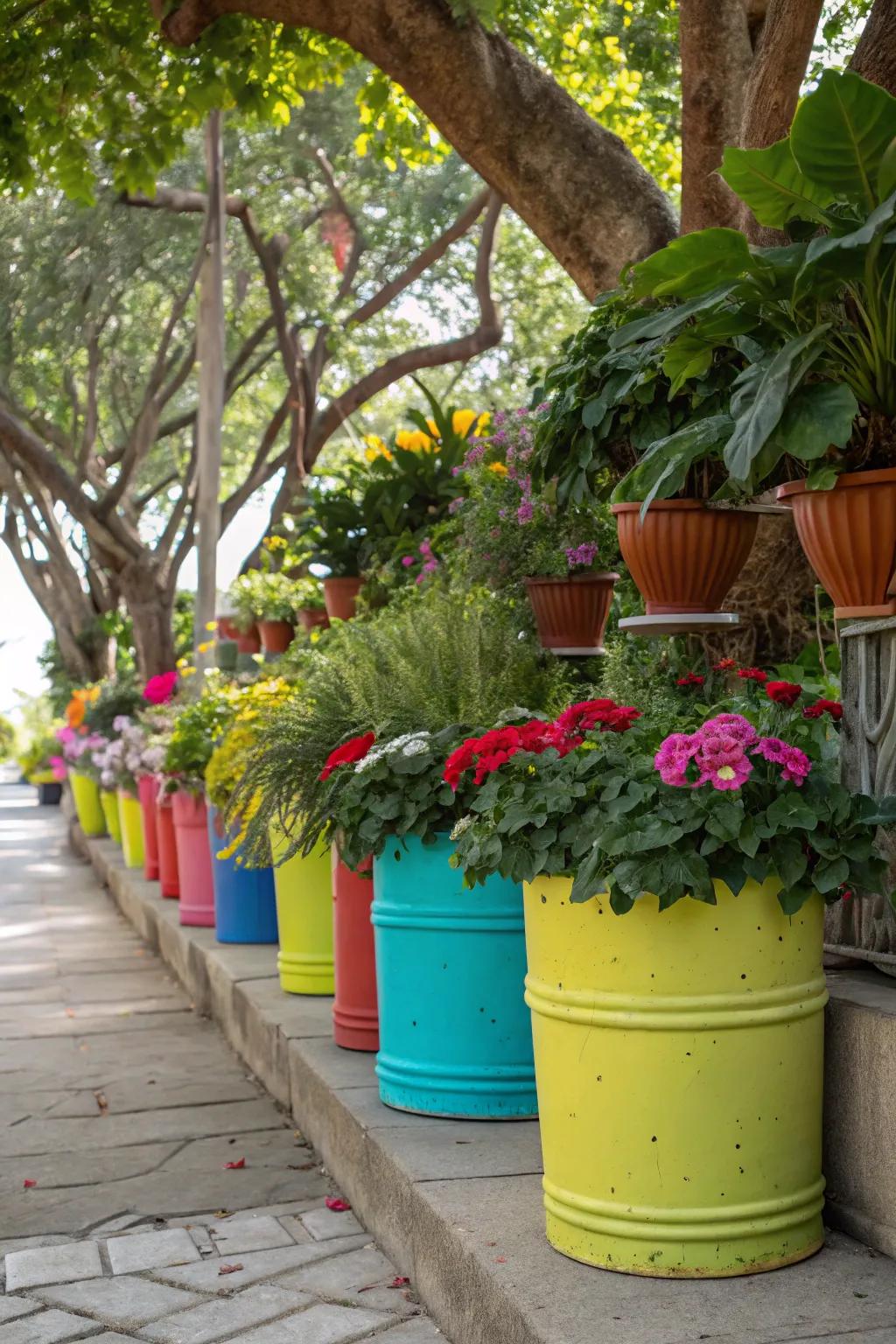
Containers allow you to introduce more color and structure without disturbing the tree roots. It’s a flexible solution I often recommend for versatility.
Possibly handy products:
- Brightly Colored Garden Planters: Add a splash of color with these vibrant planters. Perfect for elevating any garden space.
- Durable Plant Container Set: Enhance your garden’s versatility with these robust, weather-resistant plant containers.
- Stackable Planter System: Maximize space usage with stackable planters. Ideal for small areas seeking vertical elegance.
19. Combine Textures for Interest
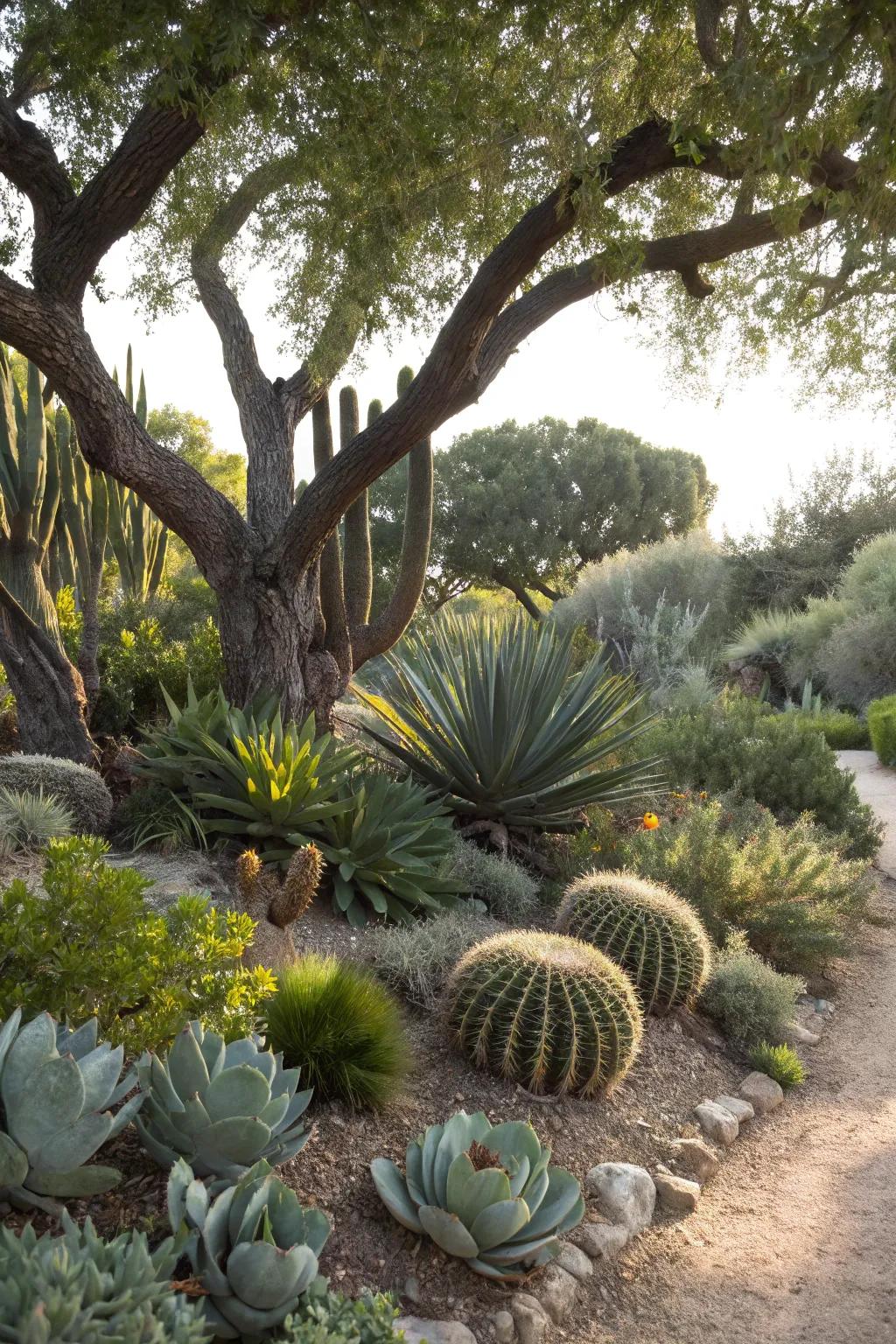
Mix plants with different textures and forms for a visually interesting garden. This is my secret to a garden that keeps you captivated.
Some ideas to consider:
- Artificial Succulent Plant Set: Add vibrant texture effortlessly with realistic faux succulents for a lasting visual appeal.
- Decorative Garden Stones: Enhance your garden’s texture and form with versatile decorative stones in varied shapes.
- Assorted Cactus Seeds Kit: Cultivate diverse textures in your garden with a variety of easy-to-grow cactus seeds.
20. Foster a Wildflower Meadow
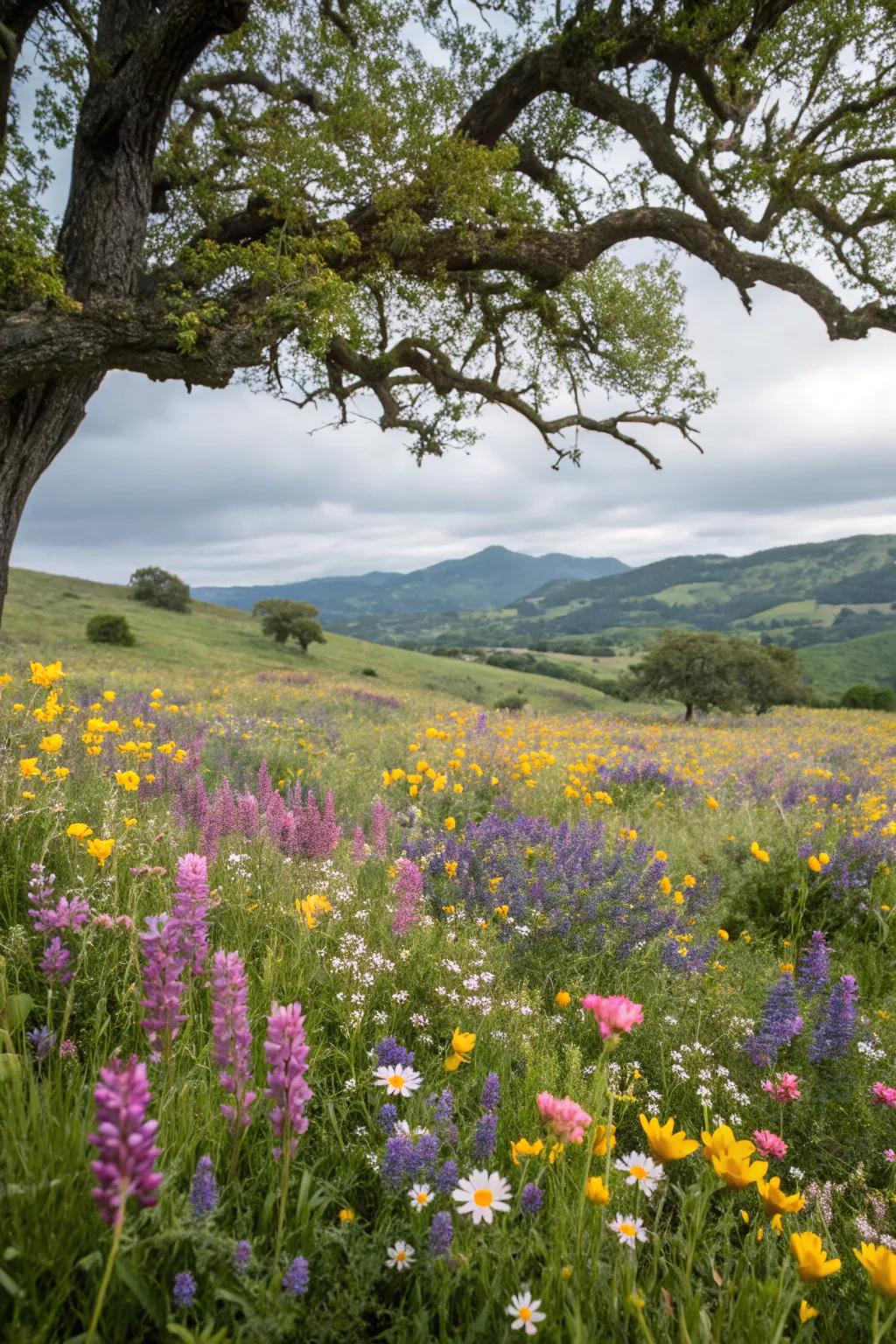
Under certain trees, a wildflower meadow can flourish, offering a burst of color and life. It’s a delightful surprise that brings joy every time I see it.
Items that may come in handy:
- Wildflower Seed Mix: Plant diverse wildflower seeds to create a vibrant, colorful meadow in your garden.
- Garden Soil Enhancer: Enrich your soil to support healthy growth of vibrant wildflowers under tree canopies.
- Flower Fertilizer: Boost the health and color of your wildflower meadow with this effective flower fertilizer.
